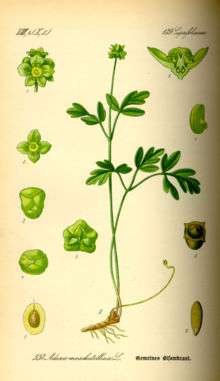Adoxa moschatellina
Adoxa moschatellina (moschatel, five-faced bishop,[1] hollowroot, muskroot, townhall clock,[2] tuberous crowfoot, Good Friday plant) is an herbaceous perennial flowering plant in the family Adoxaceae. It has a Holarctic distribution occurring at low altitudes at high latitudes and at high altitudes in the south of its range, preferring damp shady situations.[3]
| Moschatel | |
|---|---|
 | |
| Scientific classification | |
| Kingdom: | Plantae |
| Clade: | Tracheophytes |
| Clade: | Angiosperms |
| Clade: | Eudicots |
| Clade: | Asterids |
| Order: | Dipsacales |
| Family: | Adoxaceae |
| Genus: | Adoxa |
| Species: | A. moschatellina |
| Binomial name | |
| Adoxa moschatellina | |
Description
Adoxa moschatellina is a plant which forms carpets with a delicate appearance and it has rhizomes. It has thin, erect unbranched stems which end in clusters of five green flowers which are 6 to 8 millimetres (0.24 to 0.31 in) across. These flowers give the species one of its common names, "Town Hall Clock" as they face out in four directions at 90 degrees to each other, resembling the four faces of a town clock.[4] The flowers have five petals and five stamens, but the stamens are divided into two parts creating the impression that there are ten stamens. When it is not in flower it can be hard to tell A. moschatellina from other plants with similar foliage.[5] The plant and its flowers have a musk-like scent, which it emits towards evening when the dew falls. If the plant is bruised this scent disappears.[6]
Distribution
Adoxa moschatellina has a boreal, circumpolar distribution in Europe, Asia and North America.[5] It is widespread and common in most parts of the British Isles but becomes scarce in the north and west of Scotland and parts of eastern England.[7] it is absent from Ireland.[3] Its distribution in parts of Wales is localised, occurring only at sites where are base rich soil, such as Coed Dolgarrog National Nature Reserve in Conwy.[8]
Habitat and ecology
Adoxa moschatellina is a perennial rhizome bearing herb of humid brown soils under shade on the banks of rivers and streams, in deciduous woodlands and under hedgerows. It does infrequently grow in shaded base-rich localities in uplands. This is a spring flowering species and it dies back after flowering in May or June in low-lying areas. The flowers are self-fertile and this species may reproduce by producing seeds or by vegetative spread. In Britain its altitude ranges from 0 to 1,065 metres (0 to 3,494 ft) on Ben Lawers.[9] The rather plain flowers of A. moschatellina are pollinated by flies and nocturnal moths which do not rely on colour to pollinate plants.[10] It is parasitized by the rare smut Melanotaenium adoxae.[11]

References
- Collins Dictionary entry
- "Wessex Wanderings: Local parks and woodlands in Spring". Psophis.blogspot.co.uk. 2016-04-30. Retrieved 2017-04-09.
- "Adoxa moschatellina Town Hall Clock". British Wildflowers. Retrieved 23 March 2020.
- "Moschatel - Adoxa moschatellina". Nature Spot recording the Wildlife of Leicestershire and Rutland. Retrieved 23 March 2020.
- "Adoxa moschatellina - Townhall Clock or Moschatel". First Nature. Retrieved 23 March 2020.
- "Moschatel, Common". Botanical.com. Retrieved 23 March 2020.
- "Adoxa moschatellina". Online Atlas of the British and Irish Flora. Botanical Society of Britain and Ireland and Biological Records Centre. Retrieved 23 March 2020.
- "Coed Dolgarrog National Nature Reserve". Frst Nature. Retrieved 23 March 2020.
- "Adoxa moschatellina". Online Atlas of the British and Irish Flora. Botanical Society of Britain and Ireland. Retrieved 23 March 2020.
- "Adoxaceae - Town-hall Clock". Cronodon. Retrieved 23 March 2020.
- Negrean, G.; Constantinescu, O. (1997). "Melanotaenium adoxae revisited". Mycotaxon. 61: 359–362.